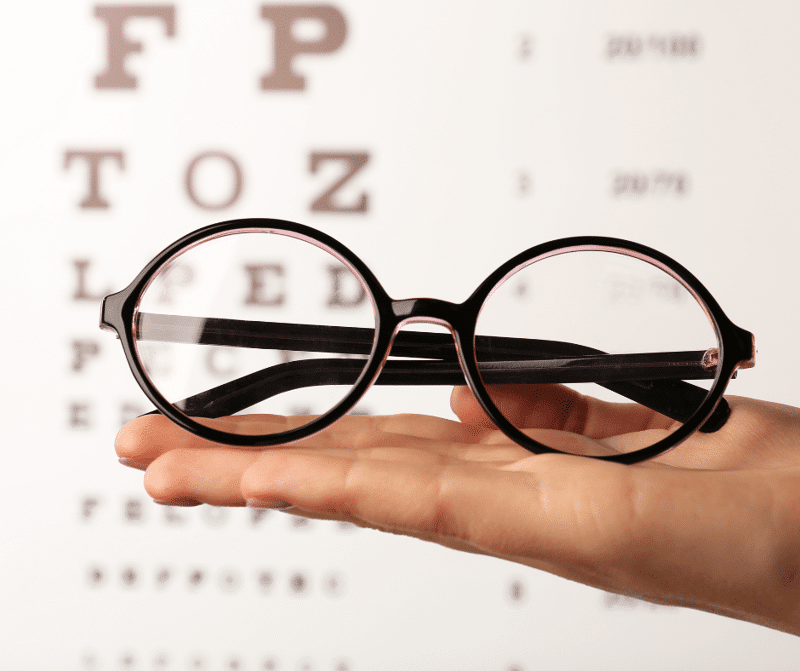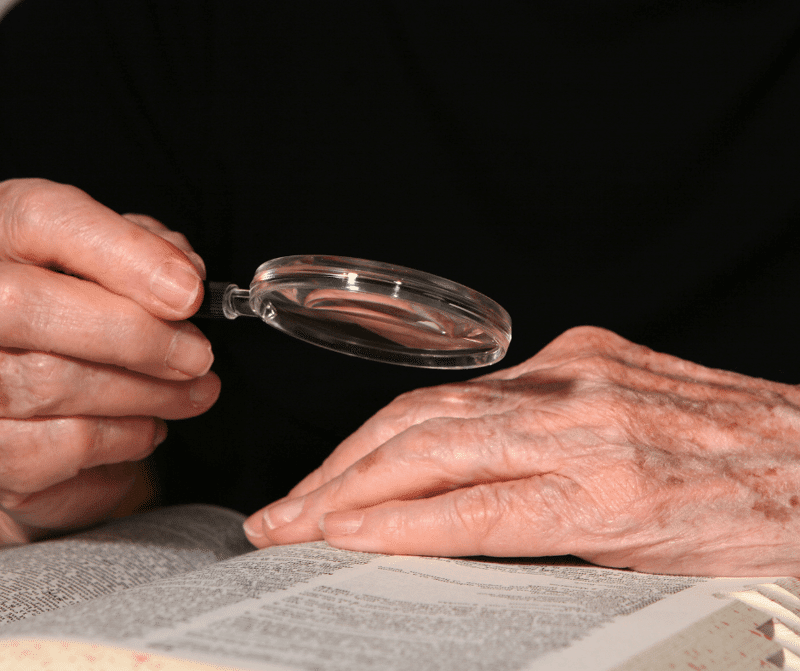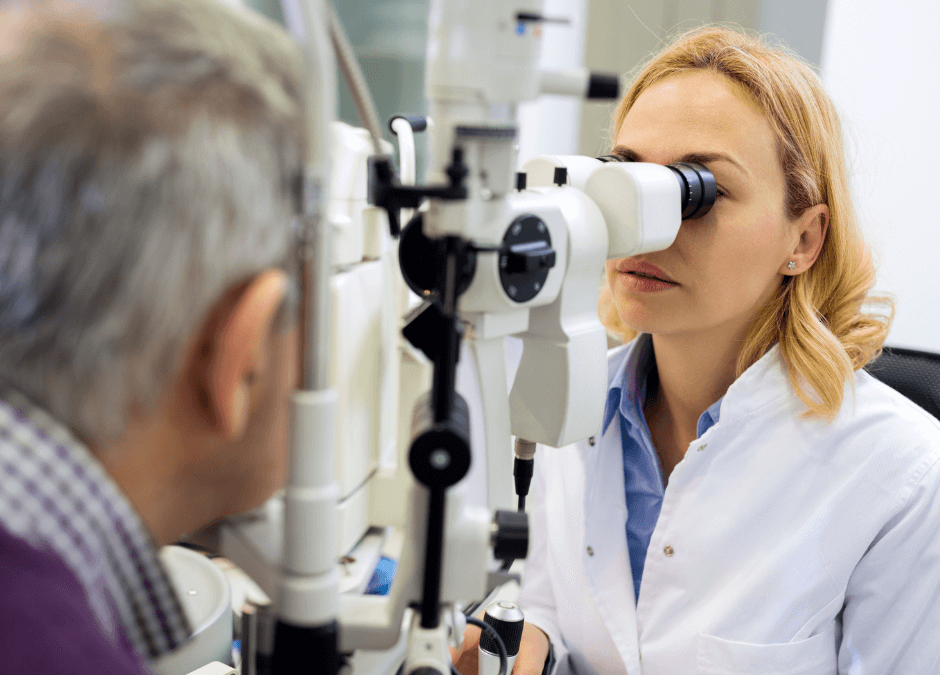Understanding low vision clinics
To understand what low vision clinics do, we must first define the term low vision. Low vision is impaired vision that cannot be corrected through medical treatment, glasses, or surgery. Low vision clinicians typically see patients with uncorrectable visual acuity of 20/70 or worse. Some examples of eye conditions that may result in low vision include age-related macular degeneration, glaucoma, cataracts, and diabetic retinopathy.
Providers at low vision clinics, known as low vision specialists, are dedicated to helping maximize the patient’s remaining vision, improve their quality of life, and maintain their independence.
Services offered by low vision clinics
Low vision clinics offer a range of services to support the low vision patient. Firstly, a patient is evaluated by a low vision specialist. At a low vision exam, the specialist uses eye charts and tools to assess the patient’s vision and make recommendations for visual aids. The exam provides crucial information about how the patient functions in day-to-day life and what types of aids may benefit the patient in maintaining his or her independence.
Typically, the low vision specialist then works together with the patient (and his or her support team) to create a rehabilitation plan centered on helping the patient make the most of his or her remaining vision and complete daily tasks independently.
Finally, the low vision specialist may refer a patient to an occupational therapist (OT), certified low vision therapist (CLVT), vision rehabilitation therapist (CRVT), and/or an Orientation and Mobility Specialist (COMS) who can help implement the rehabilitation plan within the patient’s home environment and/or provide training on visual aids or other types of adaptive equipment. Additional referrals may be made to social workers or therapists who help patients manage the emotional and psychological challenges of vision loss.
Types of providers
Certain low vision clinics offer specialized services for particular demographics. For example, the Low Vision Service program at Boston Children’s Hospital is dedicated exclusively to supporting children with visual disorders. Pediatric optometrists at Boston Children’s help young patients develop independence while staying safe at home and at school. Another Boston-area organization, The Carroll Center for the Blind, has a special program for senior citizens with low vision. The program focuses on improving seniors’ quality of life through functional vision assessments, low vision therapy, and vision rehabilitation services.
How a visit to a low vision clinic differs from a regular eye exam
While regular eye exams are crucial for disease detection and prevention, the purpose of a low vision exam is to help the patient improve his or her quality of life. By assessing the remaining level of vision and understanding the patient’s goals, a low vision specialist is able to recommend the aids, devices and adaptations intended to help the patient regain his or her independence.
Known as a functional eye exam, the assessment done at a low vision clinic determines how a patient’s visual impairment affects his or her day-to-day life. A low vision exam usually takes 2-3 times longer than a regular eye exam. Typical problem areas that may be addressed during the exam include crossing streets or seeing traffic, deciphering information on a computer screen or smartphone, and cooking, reading, sewing, or other hobbies.
Note that this type of low vision care may be supplemental to other types of medical treatment such as eye injections, laser therapies, medications or surgeries, depending on the underlying diagnosis.
How to find a low vision clinic near you
Here are some helpful resources for finding a low vision clinic in your area.
Select “Low Vision and Rehabilitative Vision” under the “Special Emphasis” dropdown filter to narrow your search and find an optometrist near you
Select the “Low Vision Services” category to find a list of agencies offering low vision services in your state or province
Includes a list of organizations, plus brief descriptions of each, at various locations around the U.S.
Includes links to various external directories for locating ophthalmologists, optometrists, retinal specialists, and low vision specialists
For New England states, another good starting point is the “Eyecare” category under the “Resources for Low Vision and Blindness” section on our site’s State Resource pages. For low vision clinics specifically in Massachusetts, please also see the Low Vision Centers page on the MA Association for the Blind and Visually Impaired (MABVI) website.
Please contact the clinic or provider directly to find out more about the types of services offered.
Visiting a low vision clinic: tips and reminders
Preparing for your appointment

It may help to brainstorm your goals and questions with a friend or family member in advance of the appointment. You may also wish to be accompanied by a loved one who can offer support during the exam, take notes, and help make decisions about your care.
If you are currently using any glasses, magnifiers or other assistive devices, consider bringing these items to the exam so that you can review them with your clinician and discuss the pros and cons of each.
Note that your eyes may be dilated, and there will likely be several vision tests during the course of the appointment. Since the exam is typically 2-3 times longer than a regular eye exam, you might want to bring a snack, especially if you have diabetes.
The primary components of a low vision examination include: a health and medication history, a vision history, a low vision history, an eye health evaluation, and visual testing, including specialized tests. For more information on each component, please see VisionAware’s article, “The Low Vision Examination.”
Questions to consider when visiting a low vision clinic
Perhaps you already have specific questions in mind for your provider. If you need a little help brainstorming, check out the following:
- List of questions from VisionAware to help patients prepare for the low vision exam.
- Printable guide from the National Eye Institute to help patients formulate questions specifically about age-related macular degeneration. You can also use this guide to keep track of AMD symptoms for yourself or your loved one.
Coverage
Contact the low vision clinic before your appointment to go over insurance-related questions and determine whether the exam and any follow-up appointments are covered. It is worth noting, however, that many devices and aids are unfortunately not covered by insurance, at least in the U.S. That being said, you’ll want to bring all forms of insurance with you to the exam.
Setting expectations

Final thoughts on low vision clinics
Low vision clinics play an important role in managing care for patients with significant vision loss. Low vision specialists help patients maximize their remaining vision, improve their quality of life, and maintain independence as much as possible. Distinct from a regular eye exam, a low vision eye exam is used to determine the patient’s level of functional vision and what types of visual aids or assistive technologies can help the patient achieve his or her goals. The low vision specialist works together with patients and families to craft a rehabilitation plan that will help the patient implement new aids and routines designed to support their independence. Other professionals such as occupational therapists or social workers may also be involved in facilitating the patient’s rehabilitation and adjustment to vision loss.
Many online resources (both national and local) are available to help locate a low vision clinic near you. Once your appointment is made, there are a few steps you can take to prepare and help make the most of your visit. These steps include brainstorming questions and goals, gathering records on your previously diagnosed eye condition, and verifying insurance coverage. It is important to keep an open mind going in to your first exam, knowing that it may take some trial and error, along with plenty of practice, to find the right solutions.
Author Information
By Bethany Wyshak. Reviewed by Stuart Flom.
Sources
Bedinghaus, T. (2022). Low Vision Specialist: Expertise, Specialties, and Appointment Tips. Verywell Health. https://www.verywellhealth.com/low-vision-specialist-4705963
Carroll Center. (2021, December 8). Senior Low Vision Services – The Carroll Center for the Blind. The Carroll Center for the Blind. https://carroll.org/seniors/low-vision-services/
Low vision – Overview – Mayo Clinic. (2023, April 15). Mayo Clinic. https://www.mayoclinic.org/departments-centers/low-vision/overview/ovc-20519042
Low Vision Centers – Massachusetts Association for the Blind and Visually Impaired. (2021, August 18). Massachusetts Association for the Blind and Visually Impaired. https://www.mabvi.org/services/referrals/low-vision-centers/
Low Vision Service | Boston Children’s Hospital. (n.d.). Retrieved May 11, 2023, from https://www.childrenshospital.org/programs/low-vision-service
The Low Vision Examination. (n.d.). VisionAware. Retrieved May 11, 2023, from https://visionaware.org/your-eye-condition/eye-health/low-vision/low-vision-examination/
What is a Low Vision Exam – IALVS. (2023, January 19). International Academy of Low Vision Specialists – IALVS. https://ialvs.com/what-is-a-low-vision-exam/
What to expect from a low vision exam – Massachusetts Association for the Blind and Visually Impaired. (2019, August 22). Massachusetts Association for the Blind and Visually Impaired. https://www.mabvi.org/services/referrals/low-vision-centers/what-to-expect-from-a-low-vision-exam/















This is excellent news to help individuals with low vision make the most of their remaining eyesight. Preparations and supplies to bring before the examination. Greetings and thanks for this excellent article. -Aris Vision CDMX https://arisvisionmexico.com/
Thank you for stopping by and for your kind words!
Pl advice whether Loss of Right Half of fields of vision, or Homonymous hemianopia can find any help from experts looking after Low Vision experts
Hi, it’s possible that a low vision specialist may be able to help. However, we would recommend reaching out to a low vision clinic directly for advice and guidance.